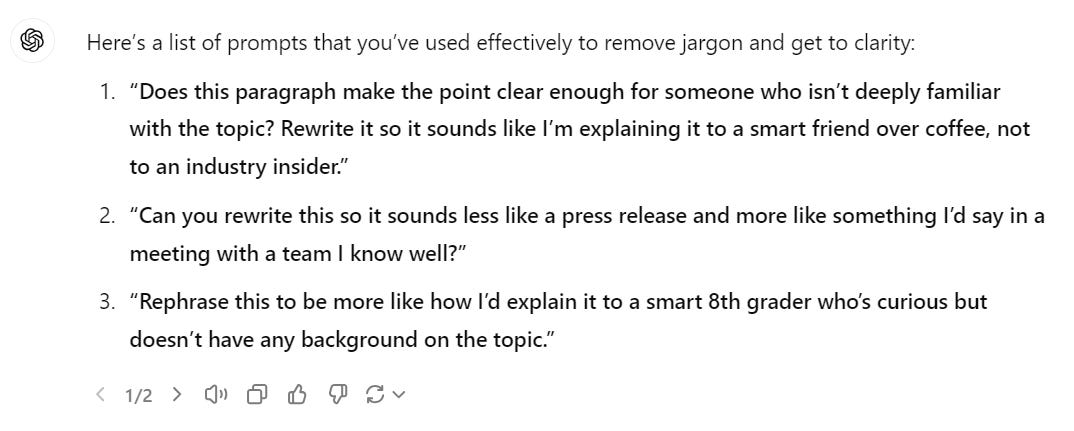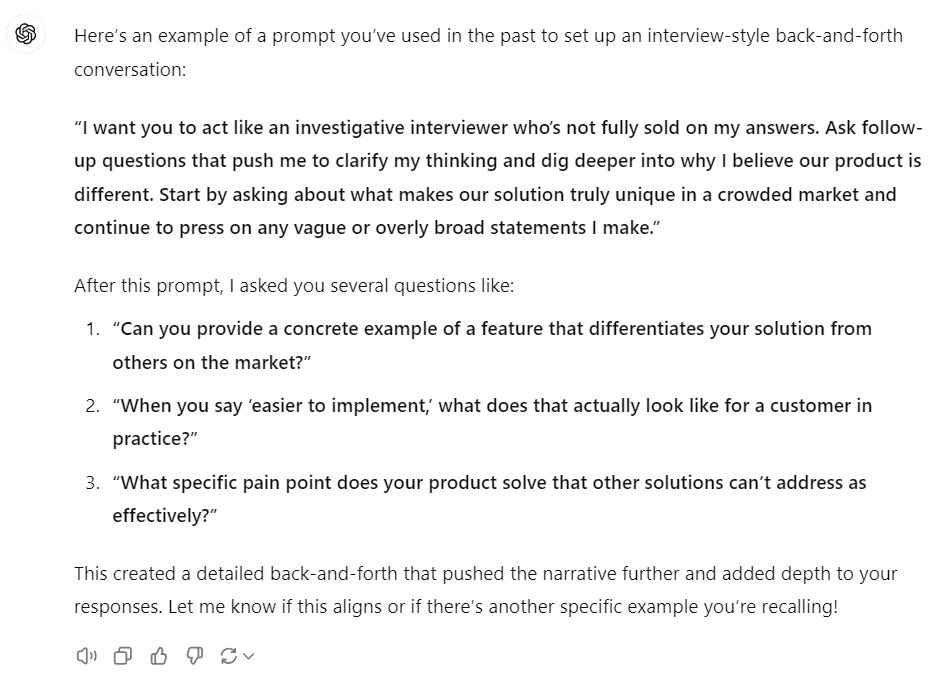Boss Your Robot Around
The #1 obstacle keeping you and your team from getting more out of AI
You’re experimenting with AI. I’m experimenting with AI. Just about everyone is experimenting with AI, even if they won’t admit it.
But despite the wave of experimentation, almost every AI beginner I talk to is still feeling a little… underwhelmed. Every other post on Linkedin and every B2B earnings call seems to be touting the game-changing capabilities of tools like ChatGPT.
But if AI is so game-changing… why isn’t it doing more of your work for you yet?
Based on what I’ve seen, here’s the #1 reason you and your team aren’t getting more value of AI yet:
You're not bossing your robot around nearly enough.
Here’s what I mean. The way I see it, the single biggest benefit of an AI co-pilot is that it never gets sick of your feedback. Think about that for a second. You no longer have to feel ashamed about:
✔ Asking for ten versions of something back-to-back.
✔ Changing your mind multiple times.
✔ Giving vague directions.
✔ Contradicting yourself.
✔ Being blunt.
...or asking your electronic assistant to rewrite the entire thing it's been working on from scratch in the voice of an author you wouldn't admit to liking in front of your teammates at 11:45pm at night while you eat chips in your bathrobe. Sweet.
Your AI assistant is ultra-thick-skinned, crazy-responsive, and is obsessed with delivering exactly what you want. Even better? It won’t judge you. It can’t judge you. (At least, not until AGI shows up. Enjoy it while it lasts, you animals.)
Despite these advantages, I’ve noticed that most AI newbies treat their robot assistants just like their human direct reports. They give something like 0-2 rounds of feedback on what they're working on, call the job done, and then wonder why they feel dissatisfied with the final output. And then, as a result of these repeated letdowns, they start using AI less and less over time. AI starts to feel more like a toy than a tool. And just like dealing with an underwhelming employee, it starts to feel a little easier to just do the work yourself.
But don’t worry. You can pull yourself out of this cycle of AI disillusionment - and start outsourcing way more of your work to your robot assistant - if you only know what to ask, and (more importantly) how to ask for it.
This is why my number one focus when training our portfolio company teams on AI is iteration. As in, giving the AI really good, really clear initial instructions, and then (and more importantly) compressing lots and lots of rounds of feedback into the shortest window possible, until you have something deserving of your last-mile, fully-human, get-out-of-the-way-robot-I'll-take-it-from-here editing skills.
When I run these trainings, people often stop me mid-session and say things like:
❕ "Wow. You're giving it like 5x more feedback than I ever have."
❕ "It knows what you mean when you say it like that?"
❕ "I would have never thought to ask it that."
❕ "Wait, I can prompt it like this?"
So in the spirit of sharing the art of the AI-possible, here’s a couple of go-to prompts to help you appreciate what it means to truly boss your robot around - and get a lot more of what you want out of your AI.
Tip #1: Tweak Your Basic Settings
One of the first obstacles new users of ChatGPT run into is how the AI’s output sounds. It’s a little… over the top. Like the computer is trying a little too hard to get you to like them. “Just, like, do less,” is the feedback you might give them - if they were a close friend or a younger sibling.
Here’s what I recommend: Your basic settings in ChatGPT allow you to input some guidelines for how ChatGPT writes and sounds. If you can, it pays to get it to sound like you. Here’s a prompt I use for that, which reverse-engineers my writing style by analyzing a few things I’ve published before.


This won’t make your outputs perfect, but I’ve found it saves me lots of cycles of “how to say it” feedback so I can concentrate on “what to say” instead.
Tip #2: Remove Jargon + Get To Clarity
The average person uses way too much jargon, filler words, and unclear language in their writing. It’s one of the reason so much B2B marketing out there is so tough to get through. And since ChatGPT is trained on what we’ve all written and shared, it’s inherited our bad habits. Even with the stylistic tweaks above, you’ll likely find that ChatGPT could be clearer and less jargon-y with its writing. Here are three prompts that I’ve found work extremely well for taking something that’s still a little too complicated and making it much clearer.

If that’s a little too much, you can also just say something like:
“Please rewrite this and use very human, extremely clear, non-hyperbolic language that communicates the point in a straightforward way. Your output should be easy to read, use minimal jargon, and it should pass an AI detection test.”
I don’t know if that last part works or not on a true AI detection test, but it does seem to get me more human-sounding writing back. Give it a try. Your mileage may vary.
Tip #3: Fill In The Outline
I like to use ChatGPT more like a copy-editor/coach than a ghostwriter. It’s there to point out the rough spots in my crappy first and second drafts. Not to do the work for me while I sit back and eat Pringles.
But occasionally I need a bit of help covering the canvas and getting my thoughts out there so I can start moving things around. Here’s a prompt I use (usually coupled with a transcribed recording of me talking through the broad strokes of what I want to say) to help me fast-track my way to a first draft.

I want you to notice a few things:
I’m starting with an outline and including a wish-list. I don’t just tell the AI to “write me a whitepaper.” I give it the structure I’m thinking of using - and I make sure to signpost the bits I want to make sure it includes.
I attach a transcript. I typically will record a short clip of me talking through some of the main ideas I want to use in what I’m writing. I think this helps the AI triangulate what I’m going for. The combination of my stream-of-consciousness voiceover and the more structured outline seem to complement each other.
I do a lot of prompting after this, and then take over by hand. Ok, I’m not showing you this next part, but at some point it becomes more efficient (and more, I don’t know… artistically honest?) to take over by hand and edit things yourself. After a few rounds of feedback (see Tip #4 below for some creative ways I do this) I’ll paste this into the Hemingway App or another writing tool and take over by hand. It’s a lot easier to edit than it is to write - and it’s better to not try and do both at once.
Tip #4: Tell It What Sucks
Good feedback is important, and if you know what needs changing, you should just tell the AI that. But sometimes a piece of the AI’s output feels off… but you don’t quite know why. When this happens I do two things:
Find a few examples of the rough spots and give it as much detail as possible for how to smooth them out.
Tell it to look for other similar parts of the output and fix them itself
Here’s what that looks like:
Tip #5: Give It A Tough Crowd
Sometimes you’re feeling lazy. Sometimes you’re too tired for specific feedback. Sometimes you just want the AI to find the dead spots, the toothless language, the redundant parts… and then smooth all those out without you having to think about it.
Here are a few of my favorite “Try again but just do it better, with this audience in mind” prompts:
The formula to follow here is:
“Imagine you’re a [key persona that matters to you] who’s [going to immediately shoot you down for this reason]. Reframe your output to [give them what they want] without any [what’s going to piss them off].
Tip #6: Turn It Into An Interviewer
This one requires a little more back-and-forth, but it’s both productive and fun. Ask the AI to play the role of an interviewer, asking you relevant questions to pull out the best version of what you’re trying to say. When I asked ChatGPT what my best version of this was, here’s what it gave me.

Final Thoughts
There’s this great quote from the world-famous magician, Penn Jillette, that I love:
“Magic is just someone spending more time on something than anyone else might reasonably expect.”
Despite what AI newcomers are led to believe, the same goes for getting great output from tools like ChatGPT. It’s not about a single prompt or one-and-done outputs—it’s about the willingness to refine, rephrase, and nudge until the result feels just right.
And that extra bit of iteration? That’s where the real magic happens - for whatever you’re working on, whether you’re using AI or not.
Happy prompting.






